Ivan Čuk
Editorial
William A. Sands, Jenni R. McNeal, Michael H. Stone
THERMAL IMAGING AND GYMNASTICS INJURIES:A MEANS OF SCREENING AND INJURY IDENTIFICATION
Trewor Dowdell
IS GYMNASTICS A DANGEROUS SPORT IN THE AUSTRALIAN CLUB CONTEXT?
Olivia Donti, Kalliopi Theodorakou, Spiros Kambiotis, Anstasia Donti
SELF-ESTEEM, TRAIT ANXIETY AND PARENTAL EDUCATIONAL LEVEL OF CHILDREN PRACTICING NON-COMPETITIVE GYMNASTICS SPORTS
Sunčica Delaš Kalinski, Ana Božanić, Almir Atiković
INFLUENCE OF DANCE ELEMENTS ON BALANCE BEAM RESULTS
Maja Bučar Pajek, Warwick Forbes, Jernej Pajek, Bojan Leskošek, Ivan Čuk
RELIABILITY OF REAL TIME JUDGING SYSTEM
Ivan Čuk
Editorial
Science of Gymnastics Journal 2011 3 2.pdf
Dear friends,
our activity since the last issue was aimed into adding our journal to international databases. So far we have succeeded to get indexed in OPEN-J GATE, GET CITED, ELECTRONIC JOURNAL INDEX, SCIRUS, NEW JOUR, INDEX COPERNICUS and GOOGLE SCHOLAR. In year 2013 we will be evaluated by Thomson Reuters for entering into science citation index and to calculate journal impact factor, which is one of our important goals. We hope that our articles will be continuously bringing new ideas and knowledge and bring enough impact to be cited in the other articles.
The last issue of Journal was visited by more than 6500 visitors, what gives us a true compliment for our endeavor. Recently opened forum for visitors to express their views has not started its true life yet. Perhaps it was set too complicated to join the forum. However we would like very much to get the feedback from you, so you are invited again to send us e-mails to our address scgym@fsp.uni-lj.si. Let us know what you think about this forum and also do not hesitate to send any other comments, suggestions or ideas. We are also preparing a new system for managing articles which should get launched by the end of this year. It is based on the ScholarOne Manuscripts application. With it the authors, reviewers and editors will be able to use the new system with much improvement in the ease of management of articles.
In June (17 - 19th) FIG organizes MAG, WAG and TRAMPOLINE symposium on the Code of Points. We aim to publish the article about what was going on in Zürich (SUI). Also, if you are organizing scientific symposium with gymnastics topics, let us know as we are very much willing to publish the information about your work on the World Wide Web.
The June issue of the Journal starts with the article on thermography. William A Sands, Jenni R McNeal and Michael H Stone from USA restored importance of the thermograhy in diagnosis of the injuries since some other diagnostic means did not show the injuries. It is interesting to see that thermography went through phases of development, with a huge gap in use (and published works) for about twenty years. Therefore in high performance sport thermography can be an important additional tool in detection and defining the causes of pain and injury.
The second article from Trevor Dowdell, Australia, is also dealing with medical topics. One of the main questions that often bother us is of course how dangerous gymnastics as a sport is? The FIG’s effort to promote safe gymnastics (FIG Academy, FIG Sympossium on safe gymnastics) is well known, however only few articles so far really provided a comparison to other sports. The results reported are favorable for gymnastics, as they clearly show that it is not a more dangerous sport when compared to others, but still we have to be focused on proper methodology and safety issues in gyms. One injury is already too much.
The third article comes from Greece. Olivia Donti, Kalliopi Theodorakou, Spiros Kambiotis and Anstasia Donti studied how some social characteristics from parents determine self esteem in children who are involved in non competitive gymnastics. Mothers are the key factor in child’s self esteem and it seems that we should be focusing on mothers when promoting gymnastics.
The last two articles cover Code of Points topics. The fourth one is written by Sunčica Delaš Kalinski, Ana Božanić (both Croatia) and Almir Atiković (Bosnia and Herzegovina) and analyses how dance elements influence balance beam scores. It is found that high difficulty dance elements are a very good predictor of the difficulty value and final score. It looks that a new (old) task for coaches and gymnasts is discovered, if they want to step on award podium.
The last article is from Slovene and Australian authors. Maja Bučar Pajek, Warwick Forbes, Jernej Pajek, Bojan Leskošek and myself were determining the reliability and validity of the Real Time Judging System developed by Australian Institute of Sport in collaboration with Faculty of Sport in Ljubljana. The system showed promising results and has already been tested during the European Championship in Berlin in April this year.
I wish you a pleasant reading and a lot of inspiration.
William A. Sands, Jenni R. McNeal, Michael H. Stone
THERMAL IMAGING AND GYMNASTICS INJURIES:A MEANS OF SCREENING AND INJURY IDENTIFICATION
Gymnasts have a relatively high injury rate and severity with highly qualified gymnasts suffering the most. One of the common injuries in gymnastics is the overuse-type that often remains latent until near the decisive moments of competition when the injury rises to the level of incapacitation. Is there a technology and methodology available to monitor gymnasts during development that can identify latent injuries and thus alert medical personnel to potential performance-limiting problems at the earliest possible time? Imaging consists of the use of a thermal camera to identify inflamed areas and asymmetric temperature patterns. Thermal asymmetries are determined via thermal image and pain is assessed with palpation, history, and subject identification. Video recordings are made of the involved areas and recorded electronically for transfer to physicians, physical therapists, and athletic trainers for further investigation and remediation. This is an ongoing descriptive study of the use of thermal imaging on inflammation and injury in gymnasts. Thermal differentiation of tissue areas is performed by visual inspection and bilateral comparison of the thermal images. Thermal images show bilateral and tissue area thermal differentials by differences in gray scale. This information discriminates injuries, inflammation, and other conditions without invasive procedures. The ability to identify and thus treat injuries while they are minor is a significant improvement over waiting until the injuries become increasingly symptomatic and performance-limiting. Thermal imaging has become a mainstay of our laboratory in assisting young athletes in remaining injury free, making return-to-activity decisions, and collaborating with medical personnel to identify, prevent and treat injuries and other conditions.
Keywords: gymnastics, injuries, thermal imaging
Trewor Dowdell
IS GYMNASTICS A DANGEROUS SPORT IN THE AUSTRALIAN CLUB CONTEXT?
Acommon perception is that the gymnastics, especially women’s gymnastics, is more dangerous than most other sporting activities. This paper sought local sports injury information to consider the following questions. Is participation in gymnastics dangerous (in this case – more injurious) when compared with other popular Australian sports? Secondly, might reports of comparatively high injury rates in the USA University or Australian High Performance Institute women’s gymnastics context translate to the local gymnastics club context? To consider the first question two sources of information about Australian sport injury frequency and injury rates were consulted. The first was the available state injury surveillance reports that present a comparison across sports, including gymnastics and the second source of data is Australian hospital admissions due to sport injury. To consider the second question, a compilation of gymnastics injury rate studies was undertaken. Journal articles pertaining to gymnastic injury rates were located via searches in PubMed and Google Scholar. Secondly, gymnastics injury rates studies over the last three decades are listed and considered in terms of club-based and scholastic based results to shed light on the potential injury rates in the Queensland and Australian gymnastics club context. The mean injury rate (per 1000 hours of participation) in club-level gymnastics is is 2.65 (95% confidence interval 0.87 - 4.43) which is below injury rates for other popular club-level Australian sports. Based on this review, gymnastics does not present the higher hospital emergency department presentations and hospital admission injury numbers, injury rates, and types of injuries found in other Australian sports.
Keywords: artistic gymnastics, injuries, injury rate.
Olivia Donti, Kalliopi Theodorakou, Spiros Kambiotis, Anstasia Donti
SELF-ESTEEM, TRAIT ANXIETY AND PARENTAL EDUCATIONAL LEVEL OF CHILDREN PRACTICING NON-COMPETITIVE GYMNASTICS SPORTS
The aim of this study was to examine the relation between self-esteem, trait anxiety and parental educational level of 117 children (M age= 10.61 years, SD=O.7), practicing non-competitive gymnastics sports. To measure self-esteem and trait anxiety, the Greek versions of Harter’s Self-Perception Profile for Children (1985a) and of the State-Trait Anxiety for Children (STAIC; Spielberger, Edwards, Lushene, Montuori, & Platzek, 1973) were used respectively. ANOVA procedure and independent samples t-test were performed in order to examine differences in self-esteem and trait anxiety between the different educational levels of the parents. Results indicated that father’s educational level was related only to one subscale of self-esteem (social acceptance) and had no relation with trait anxiety while mother’s educational level was related to most of the subscales of self-esteem (school competence, athletic competence, social acceptance and physical appearance) and to trait anxiety. When both parents’ educational level was examined simultaneously, results indicated that children with parents of higher educational level scored higher in most of the subscales of self-esteem (school competence, athletic competence, social acceptance and physical appearance) but not in behavioral conduct and global self-esteem, and there was no difference in trait anxiety. Further research is required on the impact of structural features of the family on young athletes’ psychological parameters.
Keywords:self-esteem, trait anxiety, gymnasts, parents, education
Sunčica Delaš Kalinski, Ana Božanić, Almir Atiković
INFLUENCE OF DANCE ELEMENTS ON BALANCE BEAM RESULTS
According to the Code of Points (FIG, 2009) the balance beam difficulty value is determined by the sum of maximum 8 most difficult elements (including the dismount), fulfilling 5
composition requirements and by the values that exceed from the connections between the acrobatic elements, turns and acro-rhythmic elements. The aim of this study was to determine the frequency of performed dance elements on the balance beam and their influence on: difficulty value, execution value and final score. The sample consisted of 109 women top junior athletes, who participated in qualifications on the European Championships in Birmingham in 2010. The results obtained showed that the gymnasts in average perform 4.28 dance elements in their balance beam routines. The highest frequency was determined to a C difficulty jump ˝switch leap˝ (N=101), to two A difficulty jumps: “wolf hop or jump from cross or side position” (N=83) and to ˝Sissone˝ (leg separation 180°) take off from both legs (N=61); and to A difficulty turn: “1/1 turn (360°) on one leg – free leg optional below horizontal” (N=66). Regression analysis revealed a statistically significant influence of some dance elements on the difficulty value of the exercise (p <0.05) and on the final score. Statistically significant influence of different dance elements on the execution value was not found.
Keywords: women artistic gymnastics, juniors, difficulty, execution, code of points.
Maja Bučar Pajek, Warwick Forbes, Jernej Pajek, Bojan Leskošek, Ivan Čuk
RELIABILITY OF REAL TIME JUDGING SYSTEM
The aim of our research was to analyse the implementation of a Real Time Judging System (RTJS) . In this research, 6 volunteer international level judges evaluated male parallel bars routines from Šalamun’s memorial 2009 (World cup series B artistic gymnastics competition). The computer assisted system with a keyboard interface was used to record and display deductions from individual judges in real time. For validity assessment, the mean absolute and rank deviations of judges’ execution scores, Kendall’s W and ANOVA statistics were calculated. For consistency and reliability assessment, item-total correlations, Cronbach’s alpha coefficient, intra-class correlations and Armor’s theta were calculated. The overall results in terms of consistency (Cronbach’s alpha mostly above 0.96) and reliability (Armor’s theta 0.95, intra-class correlation for single and average measures 0.77 and 0.95, respectively) were satisfactory. As compared to results of judging analysis from a previous high level competition at Universiade 2009 higher indices of individual judge bias were found. In conclusion, RTJS shows promise as an efficient system to increase the transparency and informative value of judging while maintaining the same level of reliability.
Keywords: artistic gymnastics; information technology; panel judging; bias.








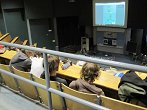
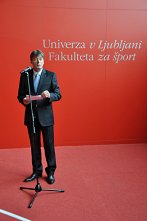






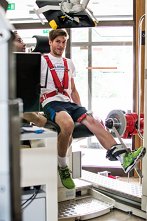

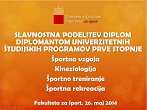

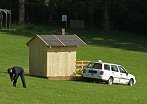



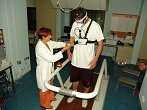
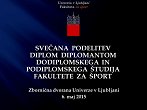








.png)